
🚗⚡ A world where the hum of engines is replaced by the whisper of electric motors, where charging stations outnumber gas pumps, and where your daily commute leaves zero carbon footprint. This isn’t a scene from a futuristic movie—it’s the reality that electric vehicles are rapidly ushering in.
But wait, you might be thinking, “Aren’t electric cars just a passing trend?” Think again! The electric vehicle revolution is here to stay, and it’s transforming the way we think about transportation. From sleek sports cars to family-friendly SUVs, EVs are not just eco-friendly alternatives; they’re becoming the smart choice for drivers worldwide.
Curious about how electric vehicles could change your life on the road? Wondering if they’re really as green as they claim to be? Or perhaps you’re simply overwhelmed by the choices in this electrifying new market? Don’t worry—we’ve got you covered. In this comprehensive guide, we’ll cruise through everything from the basics of EV technology to the exciting future that lies ahead, helping you navigate the electric landscape with confidence. Buckle up as we explore the world of electric vehicles, their benefits, challenges, and how to choose the perfect EV for your lifestyle!
Understanding Electric Vehicles

A. What defines an electric vehicle
Electric vehicles (EVs) represent a revolutionary shift in transportation technology, fundamentally changing the way we think about personal mobility and energy consumption. At its core, an electric vehicle is defined by its use of one or more electric motors for propulsion, powered by rechargeable battery packs, instead of relying on traditional internal combustion engines fueled by gasoline or diesel.
The defining characteristics of an electric vehicle include:
- Electric Powertrain: Unlike conventional vehicles that use gasoline or diesel engines, EVs are propelled by electric motors. These motors convert electrical energy from the battery into mechanical energy to drive the wheels.
- Rechargeable Battery: The heart of an electric vehicle is its high-capacity battery pack, typically lithium-ion batteries. These batteries store electrical energy and power the electric motor(s).
- Charging System: EVs can be recharged by plugging into an external power source, such as a home charging station or public charging infrastructure.
- Regenerative Braking: Many EVs employ a system that captures kinetic energy during braking and converts it back into electrical energy, storing it in the battery for later use.
- Zero Direct Emissions: Electric vehicles produce no tailpipe emissions, making them significantly cleaner in operation compared to conventional vehicles.
- Silent Operation: Due to the absence of a combustion engine, EVs operate much more quietly than traditional vehicles.
- Instant Torque: Electric motors provide full torque from a standstill, resulting in quick acceleration and responsive performance.
These defining features contribute to the unique driving experience and environmental benefits associated with electric vehicles. As we delve deeper into the world of EVs, it’s crucial to understand the various types available in the market today.
Get more about engine, click on this link: Engine
B. Types of electric vehicles
The electric vehicle market has evolved to include several distinct types, each with its own set of characteristics and advantages. Understanding these different types can help potential buyers make informed decisions based on their specific needs and preferences. Let’s explore the main categories of electric vehicles:
- Battery Electric Vehicles (BEVs)
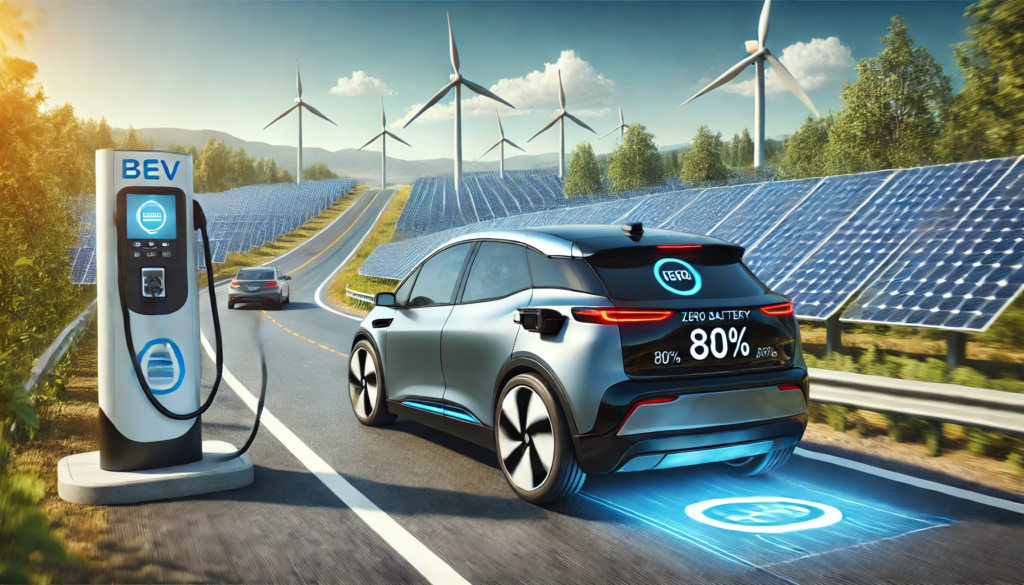
Battery Electric Vehicles, often simply called “electric cars,” are the purest form of electric vehicles. They are powered solely by electricity stored in rechargeable battery packs.
Key features of BEVs:
- Run exclusively on electricity
- No internal combustion engine
- Zero direct emissions
- Require charging from external power sources
- Typically have a range of 100-400 miles on a single charge
Examples: Tesla Model 3, Nissan Leaf, Chevrolet Bolt
- Plug-in Hybrid Electric Vehicles (PHEVs)
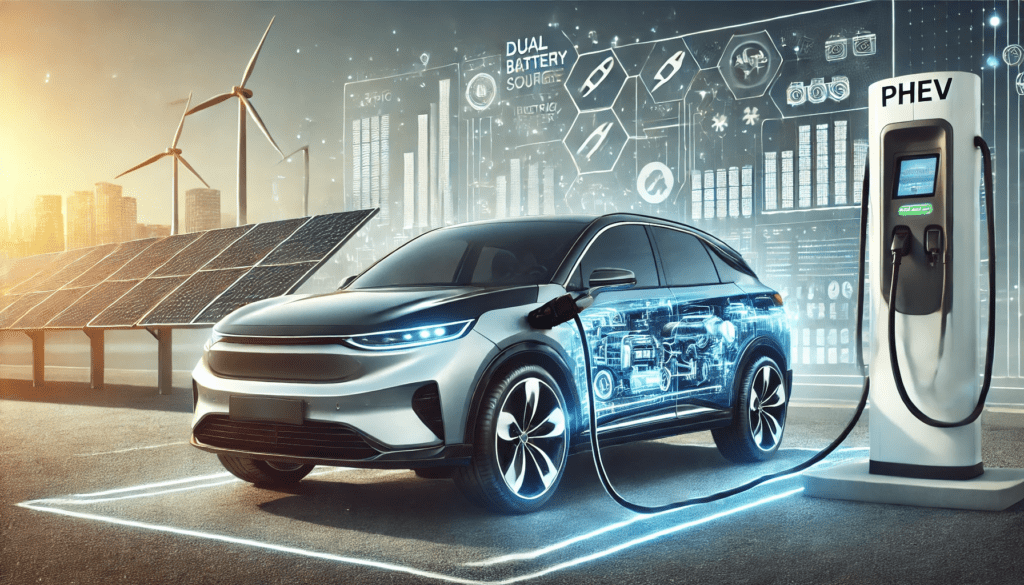
PHEVs combine elements of both electric and conventional vehicles. They have a battery pack that can be charged from an external power source, as well as an internal combustion engine.
Key features of PHEVs:
- Can run on electricity for a limited range (typically 20-50 miles)
- Switch to gasoline engine when battery is depleted
- Offer flexibility of using electricity for short trips and gas for longer journeys
- Reduced emissions compared to conventional vehicles
Examples: Toyota Prius Prime, Chevrolet Volt, BMW i3 REx
- Hybrid Electric Vehicles (HEVs)
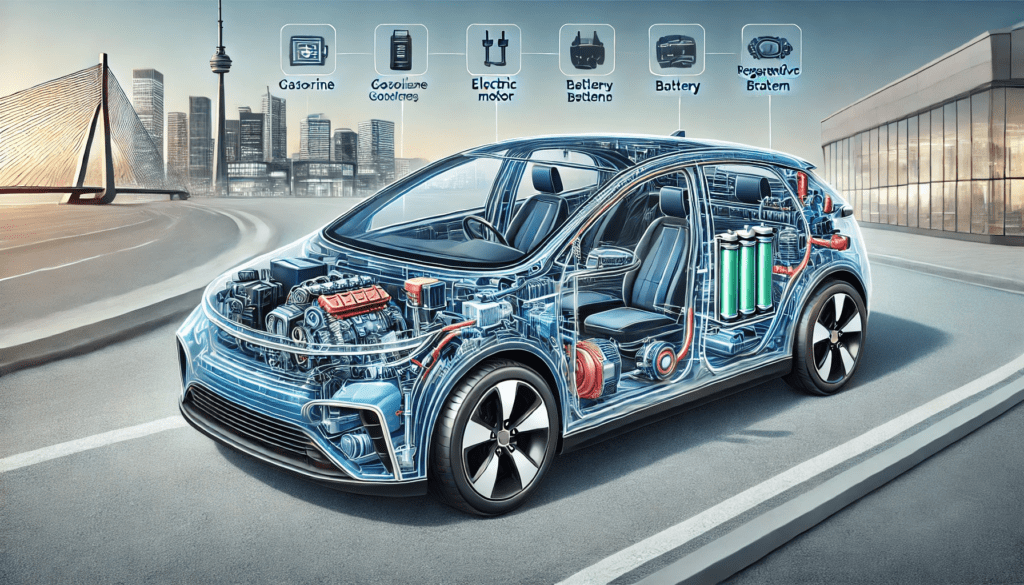
While not purely electric, HEVs are an important stepping stone in the evolution of electric vehicles. They combine a gasoline engine with an electric motor and battery, but cannot be plugged in to charge.
Key features of HEVs:
- Battery charges through regenerative braking and the gasoline engine
- Electric motor assists the gas engine, improving fuel efficiency
- Cannot run on electricity alone for extended periods
- Lower emissions than conventional vehicles, but higher than BEVs or PHEVs
Examples: Toyota Prius, Honda Insight, Ford Fusion Hybrid
- Fuel Cell Electric Vehicles (FCEVs)

FCEVs use hydrogen fuel cells to generate electricity onboard, which then powers an electric motor. While less common than other types of EVs, they represent an exciting frontier in clean transportation.
Key features of FCEVs:
- Use hydrogen as fuel, producing only water vapor as emissions
- Can be refueled quickly, similar to conventional vehicles
- Offer long driving ranges, typically 300-400 miles
- Limited by the scarcity of hydrogen refueling infrastructure
Examples: Toyota Mirai, Hyundai Nexo, Honda Clarity Fuel Cell
To better understand the differences between these types of electric vehicles, let’s compare them in a table:
| Feature | BEV | PHEV | HEV | FCEV |
|---|---|---|---|---|
| Primary Power Source | Battery | Battery + Gas Engine | Gas Engine + Battery | Hydrogen Fuel Cell |
| Can be plugged in to charge | Yes | Yes | No | No |
| Runs on electricity alone | Yes | Yes (limited range) | No (short distances only) | Yes |
| Requires gasoline | No | Yes | Yes | No |
| Typical electric-only range | 100-400 miles | 20-50 miles | 1-2 miles | 300-400 miles |
| Emissions | Zero direct emissions | Low emissions | Reduced emissions | Water vapor only |
| Refueling/Recharging time | 30 mins – 12 hours | 2-8 hours (electric) / 5 mins (gas) | 5 mins (gas only) | 5-10 mins (hydrogen) |
As the technology continues to advance, we’re seeing improvements in battery capacity, charging speeds, and overall performance across all types of electric vehicles. The choice between these different types often depends on factors such as driving habits, access to charging infrastructure, and personal preferences regarding range and environmental impact.
C. Key components of an EV
Understanding the key components of an electric vehicle is crucial for appreciating the technology behind these innovative machines. While EVs share some components with conventional vehicles, their powertrains are fundamentally different. Let’s explore the essential elements that make up an electric vehicle:
- Electric Motor

The electric motor is the heart of an EV’s propulsion system. It converts electrical energy from the battery into mechanical energy to drive the wheels.
Key features:
- High efficiency (90-95% compared to 20-30% for internal combustion engines)
- Provides instant torque for quick acceleration
- Quieter operation compared to combustion engines
- Requires less maintenance due to fewer moving parts
Types of electric motors used in EVs:
- Permanent Magnet Synchronous Motors (PMSM)
- Induction Motors
- Switched Reluctance Motors (SRM)
- Battery Pack
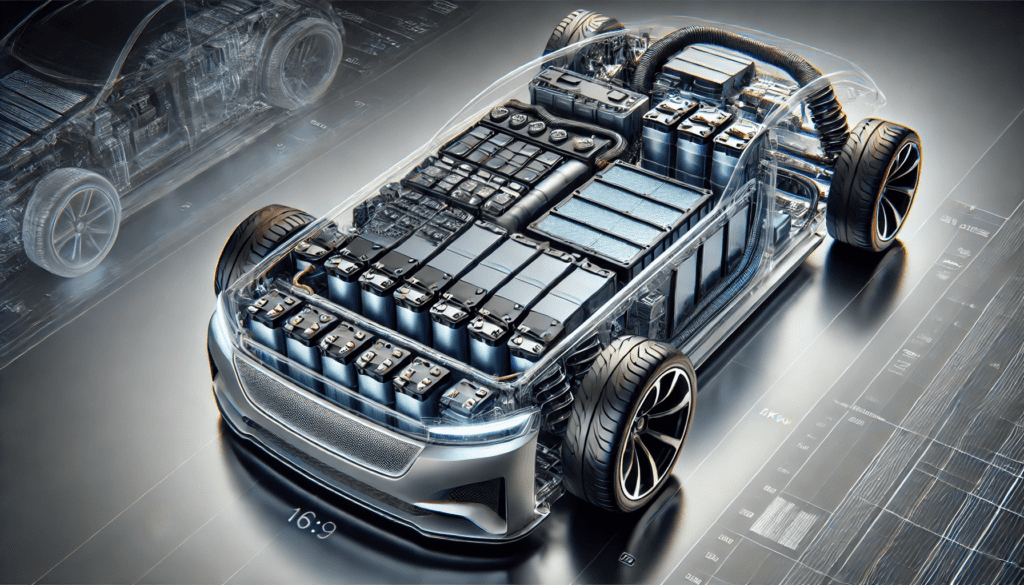
The battery pack is arguably the most critical component of an electric vehicle, storing the electrical energy needed to power the motor.
Key features:
- Typically lithium-ion chemistry due to high energy density and long life cycle
- Composed of multiple cells arranged in modules
- Determines the vehicle’s range and performance
- Largest and most expensive component of an EV
Important battery specifications:
- Capacity (measured in kilowatt-hours, kWh)
- Power output (measured in kilowatts, kW)
- Charge/discharge rate
- Thermal management system for optimal performance and longevity
- Battery Management System (BMS)

The BMS is a critical component that monitors and manages the battery pack to ensure optimal performance, safety, and longevity.
Functions of the BMS:
- Monitors individual cell voltages and temperatures
- Balances charge across cells
- Estimates state of charge (SoC) and state of health (SoH)
- Controls charging and discharging processes
- Provides safety features like overcharge and over-discharge protection
- Power Electronics
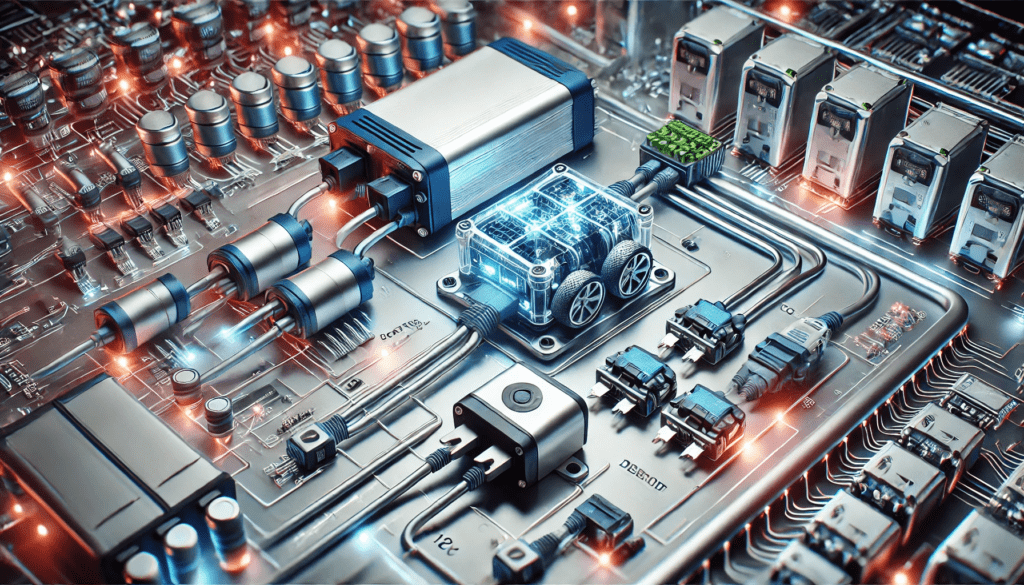
Power electronics control the flow of electrical energy between the battery and the motor, as well as manage various auxiliary systems.
Key components:
- Inverter: Converts DC power from the battery to AC power for the motor
- DC-DC Converter: Steps down high-voltage DC from the main battery to power 12V systems
- Onboard Charger: Converts AC power from the grid to DC power for charging the battery
- Charging System
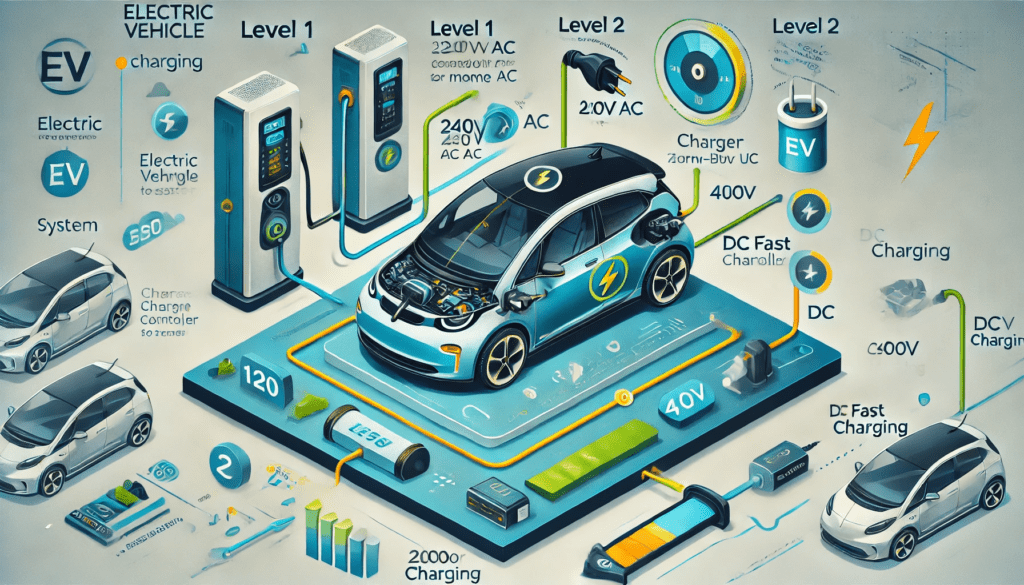
The charging system allows the EV to replenish its battery from external power sources.
Components:
- Charging Port: The interface where the charging cable connects to the vehicle
- Onboard Charger: Converts AC power from the grid to DC power for the battery
- Charge Controller: Manages the charging process and communicates with external charging stations
Types of charging:
- Level 1 (120V AC, slowest)
- Level 2 (240V AC, most common for home and public charging)
- DC Fast Charging (400V-800V DC, fastest)
- Thermal Management System

This system regulates the temperature of the battery, motor, and power electronics to ensure optimal performance and longevity.
Functions:
- Cooling the battery during fast charging and high-power output
- Heating the battery in cold conditions for improved efficiency
- Managing motor and power electronics temperature during operation
- Regenerative Braking System
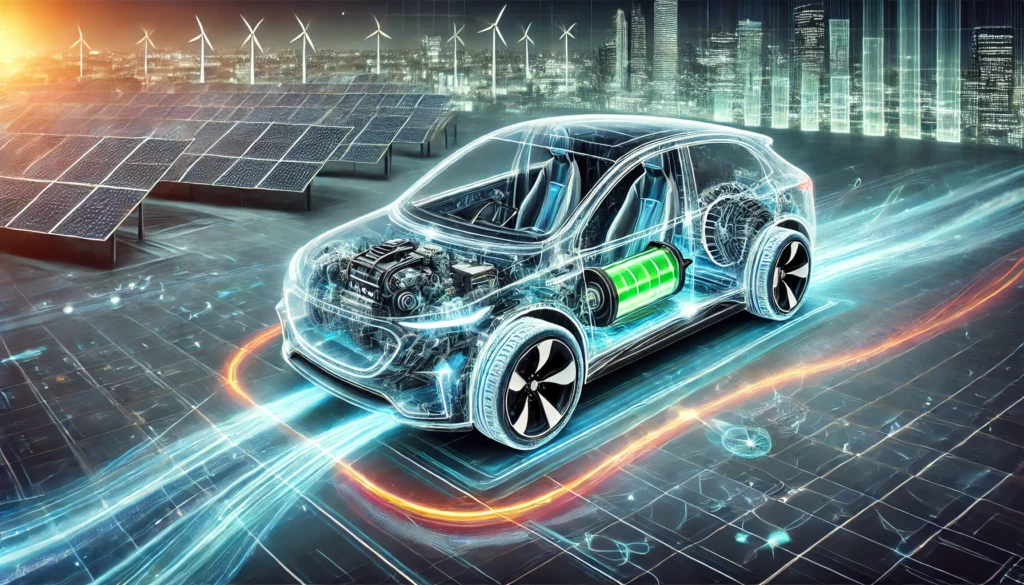
This innovative system captures kinetic energy during deceleration and converts it back into electrical energy to recharge the battery.
Benefits:
- Increases overall efficiency of the vehicle
- Extends driving range
- Reduces wear on conventional friction brakes
- Vehicle Control Unit (VCU)

The VCU is the central brain of the EV, coordinating all major systems and ensuring smooth operation.
Functions:
- Manages power distribution between components
- Controls acceleration and regenerative braking
- Monitors vehicle systems and provides diagnostics
- Interfaces with the user through the dashboard and infotainment system
- Auxiliary Systems

These are additional components that support the primary EV systems:
- 12V Battery: Powers auxiliary systems when the main battery is disconnected
- Electric Power Steering: Provides steering assistance without the need for a hydraulic pump
- Electric HVAC System: Provides heating and cooling without relying on engine heat
- Electric Vacuum Pump: Provides brake boost in the absence of engine vacuum
To better understand how these components work together, let’s look at a simplified flow of energy in an electric vehicle:
- Energy Storage: Battery Pack stores electrical energy
- Power Control: BMS and Power Electronics manage energy flow
- Energy Conversion: Electric Motor converts electrical to mechanical energy
- Motion: Wheels and transmission system propel the vehicle
- Energy Recovery: Regenerative Braking captures kinetic energy during deceleration
- Energy Replenishment: Charging System allows for battery recharging
This interconnected system of components works in harmony to provide the efficient, clean, and powerful performance that characterizes modern electric vehicles. As technology continues to advance, we can expect to see improvements in each of these areas, leading to EVs with longer ranges, faster charging times, and even better performance.
Get more about brake, click on this link: Brake
Now that we have a comprehensive understanding of what defines an electric vehicle, the various types available, and the key components that make them work, we’re well-equipped to explore the numerous benefits that electric vehicles offer. In the next section, we’ll delve into the advantages of EVs, from environmental impact to performance and cost savings.
Benefits of Electric Vehicles

Environmental impact
Electric vehicles (EVs) have emerged as a game-changing solution to combat climate change and reduce our carbon footprint. As the world grapples with the urgent need to address environmental concerns, EVs offer a promising path towards a greener future.
One of the most significant benefits of electric vehicles is their substantially lower greenhouse gas emissions compared to traditional internal combustion engine (ICE) vehicles. While it’s true that the production of EVs does generate some emissions, their overall environmental impact is considerably less than that of conventional cars throughout their lifecycle.
To put this into perspective, let’s examine a comparison of lifecycle emissions between EVs and ICE vehicles:
| Vehicle Type | Production Emissions | Use Phase Emissions | End-of-Life Emissions | Total Lifecycle Emissions |
|---|---|---|---|---|
| Electric Vehicle | Higher | Very Low | Similar | Lower |
| ICE Vehicle | Lower | High | Similar | Higher |
As we can see from the table, while EVs may have slightly higher production emissions due to battery manufacturing, their use phase emissions are significantly lower, resulting in a net positive environmental impact over time.
The environmental benefits of EVs extend beyond just reduced emissions. Here are some key ways in which electric vehicles contribute to a cleaner environment:
- Air quality improvement: By eliminating tailpipe emissions, EVs help reduce air pollution in urban areas, leading to better air quality and improved public health.
- Noise pollution reduction: Electric motors are much quieter than internal combustion engines, resulting in reduced noise pollution in cities and residential areas.
- Water conservation: The production and use of EVs require less water compared to conventional vehicles, helping conserve this precious resource.
- Ecosystem protection: By reducing the need for oil extraction and transportation, EVs help protect sensitive ecosystems from potential environmental disasters associated with these activities.
It’s important to note that the environmental benefits of EVs are closely tied to the source of electricity used to charge them. As the world transitions towards cleaner energy sources like solar, wind, and hydroelectric power, the environmental advantages of EVs will become even more pronounced.
Lower operating costs

One of the most appealing aspects of electric vehicles for consumers is their significantly lower operating costs compared to traditional gasoline-powered cars. While the initial purchase price of an EV may be higher, the long-term savings make them an economically attractive option for many drivers.
Let’s break down the various ways in which EVs offer lower operating costs:
- Fuel savings: Electricity is generally much cheaper than gasoline on a per-mile basis. The cost of charging an EV can be up to 50-70% less than fueling a comparable ICE vehicle.
- Maintenance savings: Electric vehicles have fewer moving parts and don’t require oil changes, resulting in lower maintenance costs over time.
- Tax incentives and rebates: Many governments offer financial incentives for EV purchases, further reducing the overall cost of ownership.
- Longer vehicle lifespan: Electric motors typically last longer than internal combustion engines, potentially extending the useful life of the vehicle.
To illustrate the potential savings, let’s consider a hypothetical comparison between an electric vehicle and a gasoline-powered car over a 5-year period:
| Cost Category | Electric Vehicle | Gasoline Vehicle |
|---|---|---|
| Fuel/Energy Costs | $3,000 | $7,500 |
| Maintenance Costs | $2,000 | $4,000 |
| Insurance Costs | $5,000 | $5,500 |
| Tax Incentives | -$7,500 | $0 |
| Total 5-Year Costs | $2,500 | $17,000 |
As we can see from this example, the potential savings over five years can be substantial, even when accounting for higher upfront costs of EVs.
It’s worth noting that the exact savings will vary depending on factors such as local electricity and gas prices, driving habits, and specific vehicle models. However, in most cases, EVs offer significant cost advantages over time.
Get more about fuel pressure regulator, click on this link: Fuel Pressure Regulator
Another important aspect of lower operating costs is the stability of electricity prices compared to the volatility of gasoline prices. Electricity rates tend to be more predictable and less subject to sudden spikes, making it easier for EV owners to budget for their transportation expenses.
Furthermore, as battery technology continues to improve and production scales up, the initial cost of EVs is expected to decrease, making them even more cost-competitive with traditional vehicles in the coming years.
Reduced dependence on fossil fuels

One of the most significant benefits of electric vehicles is their potential to dramatically reduce our dependence on fossil fuels. This shift has far-reaching implications for energy security, geopolitics, and the global economy.
Here are some key ways in which EVs contribute to reduced fossil fuel dependence:
- Diversification of energy sources: EVs can be powered by electricity generated from a variety of sources, including renewable energy like solar, wind, and hydroelectric power.
- Increased energy efficiency: Electric motors are significantly more efficient at converting energy into motion compared to internal combustion engines.
- Energy storage capabilities: EV batteries can potentially serve as distributed energy storage systems, helping to balance the grid and integrate more renewable energy sources.
- Reduced oil imports: For many countries, widespread EV adoption can lead to a significant reduction in oil imports, improving energy security and trade balances.
To better understand the impact of EVs on fossil fuel consumption, let’s examine a comparison of energy source diversity between EVs and conventional vehicles:
| Energy Source | Electric Vehicles | Conventional Vehicles |
|---|---|---|
| Oil | Minimal | Primary |
| Natural Gas | Possible (via electricity generation) | Limited |
| Coal | Possible (via electricity generation) | None |
| Nuclear | Possible (via electricity generation) | None |
| Solar | Possible (via electricity generation) | None |
| Wind | Possible (via electricity generation) | None |
| Hydroelectric | Possible (via electricity generation) | None |
As we can see, EVs offer a much more diverse range of potential energy sources, reducing reliance on any single fuel type.
The transition to electric vehicles also has significant geopolitical implications. Many countries currently rely heavily on oil imports, which can lead to economic vulnerabilities and political tensions. By reducing the demand for oil, EVs can help mitigate these issues and promote greater energy independence.
Moreover, the shift away from fossil fuels aligns with global efforts to combat climate change. As countries work towards meeting their commitments under international agreements like the Paris Accord, the transportation sector – a major source of greenhouse gas emissions – is a key area of focus. EVs provide a practical and scalable solution to decarbonize this sector.
It’s important to note that the full potential of EVs in reducing fossil fuel dependence can only be realized when coupled with a transition to cleaner electricity generation. Many countries are already making significant strides in this direction, with renewable energy sources becoming increasingly cost-competitive and widespread.
The reduced dependence on fossil fuels also has positive economic implications. As the EV industry grows, it creates new jobs in manufacturing, infrastructure development, and related services. This can help offset potential job losses in the traditional automotive and fossil fuel industries.
Improved driving experience

Electric vehicles not only offer environmental and economic benefits but also provide an enhanced driving experience that many users find superior to traditional gasoline-powered cars. This improved experience is a result of several unique characteristics of electric powertrains and the overall design of EVs.
Let’s explore the key aspects that contribute to the improved driving experience of electric vehicles:
- Instant torque and acceleration: Electric motors deliver maximum torque from a standstill, resulting in quick and smooth acceleration. This characteristic makes EVs particularly enjoyable to drive in urban environments with frequent stops and starts.
- Quieter operation: The near-silent operation of electric motors provides a more peaceful and relaxing driving experience, especially in city traffic.
- Smoother ride: With fewer moving parts and no need for gear changes, EVs offer a smoother and more comfortable ride compared to conventional vehicles.
- Lower center of gravity: Many EVs have their battery packs mounted low in the vehicle chassis, resulting in a lower center of gravity. This design feature enhances stability and handling, particularly during cornering.
- Regenerative braking: This feature not only improves energy efficiency but also allows for one-pedal driving in many situations, reducing driver fatigue and enhancing control.
- Advanced technology integration: EVs often come equipped with cutting-edge technology features, including advanced driver assistance systems, connectivity options, and user-friendly interfaces.
To better illustrate the differences in driving experience between EVs and conventional vehicles, let’s compare some key characteristics:
| Characteristic | Electric Vehicles | Conventional Vehicles |
|---|---|---|
| Acceleration | Instant, smooth | Gradual, may involve gear shifts |
| Noise level | Very low | Higher, especially at high speeds |
| Vibration | Minimal | More noticeable |
| Handling | Generally better due to low center of gravity | Varies depending on vehicle design |
| Braking | Regenerative braking allows for one-pedal driving | Traditional braking system |
| Maintenance stops | Less frequent | More frequent (oil changes, etc.) |
The improved driving experience of EVs extends beyond just the act of driving. Many EV owners appreciate the convenience of home charging, which eliminates the need for frequent trips to gas stations. This aspect is particularly beneficial for those who have access to home charging solutions, as they can start each day with a fully charged vehicle.
Furthermore, the reduced maintenance requirements of EVs contribute to a more hassle-free ownership experience. With no oil changes, fewer moving parts, and simpler powertrains, EVs typically require less frequent service visits, saving owners time and reducing the inconvenience associated with vehicle maintenance.
The unique characteristics of EVs also open up new possibilities for vehicle design. Without the need to accommodate a large internal combustion engine and transmission, EV designers have more flexibility in terms of interior space utilization and overall vehicle layout. This can result in more spacious interiors and innovative storage solutions.
Many EV manufacturers are leveraging this design freedom to create vehicles with distinctive aesthetics and futuristic features. From minimalist interiors with large touchscreen displays to exteriors with unique lighting signatures, EVs are often at the forefront of automotive design innovation.
It’s worth noting that the driving experience of EVs can vary significantly between different models and manufacturers. As the technology continues to evolve, we can expect further improvements in areas such as range, charging speed, and performance.
The improved driving experience of EVs is not just about personal enjoyment; it also has implications for road safety. The instant torque and responsive acceleration of electric vehicles can provide drivers with more confident merging and overtaking capabilities. Additionally, the advanced driver assistance systems often included in EVs contribute to enhanced safety on the road.
As we transition to the next section on the challenges facing electric vehicles, it’s important to recognize that while EVs offer numerous benefits, including an improved driving experience, there are still hurdles to overcome in their widespread adoption. These challenges include range anxiety, charging infrastructure development, and the need for further advancements in battery technology. However, the compelling benefits of EVs, including their environmental impact, lower operating costs, reduced dependence on fossil fuels, and improved driving experience, continue to drive innovation and adoption in the automotive industry.
Challenges Facing Electric Vehicles
Limited driving range
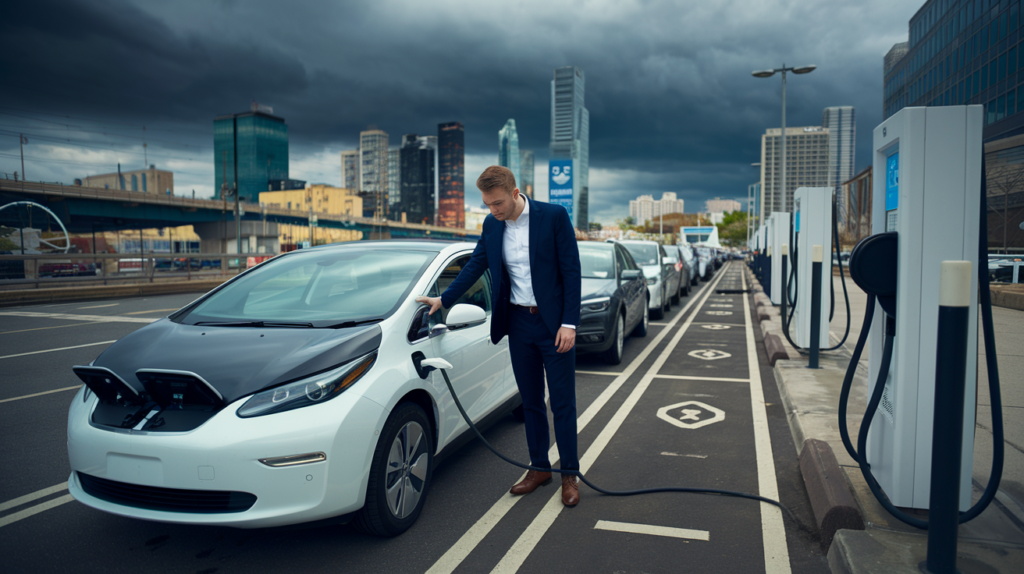
One of the most significant challenges facing electric vehicles (EVs) is their limited driving range compared to traditional internal combustion engine (ICE) vehicles. This limitation, often referred to as “range anxiety,” can be a significant deterrent for potential EV buyers.
The average range of electric vehicles has improved significantly over the years, but it still falls short of what many consumers expect from a vehicle. While some high-end EVs can now travel over 300 miles on a single charge, many more affordable models have ranges between 150-250 miles. This is in stark contrast to conventional gasoline-powered cars, which can often travel 400-500 miles on a single tank.
Several factors contribute to the limited driving range of EVs:
- Battery capacity: The size and energy density of the battery pack directly impact the vehicle’s range.
- Vehicle weight: Heavier vehicles require more energy to move, reducing overall range.
- Driving conditions: Factors like speed, terrain, and weather can significantly affect an EV’s range.
- Use of auxiliary systems: Running the air conditioning, heating, or infotainment system can decrease the range.
To illustrate the range differences between various EV models and compare them to a typical ICE vehicle, consider the following table:
| Vehicle Type | Model | Range (miles) |
|---|---|---|
| Electric | Nissan Leaf | 149-226 |
| Electric | Tesla Model 3 | 263-353 |
| Electric | Chevrolet Bolt | 259 |
| Electric | Ford Mustang Mach-E | 211-305 |
| Gasoline | Toyota Camry | 400-500 |
As we can see, even the best-performing EVs still fall short of the range offered by a typical gasoline-powered car. This limitation can be particularly problematic for:
- Long-distance travel: EV owners may need to plan their routes carefully, factoring in charging stops.
- Rural areas: Where charging infrastructure may be sparse, limiting the practicality of EVs.
- Emergency situations: Where the need for immediate, long-distance travel may arise unexpectedly.
To address the range limitation, manufacturers are working on several solutions:
- Improving battery technology to increase energy density and capacity.
- Enhancing vehicle aerodynamics to reduce energy consumption.
- Developing more efficient electric motors and power electronics.
- Implementing advanced energy management systems to optimize power usage.
While these efforts are promising, it will take time for EVs to match or exceed the range of conventional vehicles consistently. In the meantime, this challenge remains a significant hurdle for widespread EV adoption.
Charging infrastructure

Closely related to the issue of limited driving range is the challenge of charging infrastructure. The availability, accessibility, and efficiency of charging stations play a crucial role in the adoption and usability of electric vehicles.
Unlike traditional gas stations, which are ubiquitous and can refuel a car in minutes, EV charging stations are still relatively scarce in many areas and can take significantly longer to charge a vehicle. This disparity creates several challenges:
- Charging station availability: In many regions, especially rural areas, charging stations are few and far between. This scarcity can make long-distance travel in an EV challenging and increase range anxiety.
- Charging time: Even with fast-charging technology, it typically takes 30 minutes to an hour to charge an EV to 80% capacity. This is significantly longer than the few minutes it takes to fill up a gas tank.
- Charging station types: There are multiple types of charging stations with different connector types and charging speeds, which can lead to compatibility issues and confusion for EV owners.
- Grid capacity: As more EVs are adopted, there are concerns about whether the existing power grid can handle the increased demand, especially during peak hours.
- Home charging limitations: Not all EV owners have access to home charging, particularly those living in apartments or houses without dedicated parking spaces.
To better understand the different types of charging stations and their capabilities, consider the following table:
| Charging Level | Power Output | Charging Speed | Typical Use Case |
|---|---|---|---|
| Level 1 (120V AC) | 1.4 kW | 3-5 miles per hour | Home charging |
| Level 2 (240V AC) | 3.3-19.2 kW | 10-60 miles per hour | Home and public charging |
| DC Fast Charging | 50-350 kW | 3-20 miles per minute | Public charging for long trips |
The development of charging infrastructure is progressing, but it faces several challenges:
- High installation costs: Setting up charging stations, especially DC fast chargers, can be expensive.
- Permit processes: Obtaining necessary permits for installation can be time-consuming and complex.
- Maintenance: Ensuring the reliability and upkeep of charging stations requires ongoing investment.
- Standardization: Different EV manufacturers use various charging standards, complicating infrastructure development.
To address these challenges, various stakeholders are taking action:
- Government initiatives: Many governments are providing incentives and funding for the installation of public charging stations.
- Private investment: Companies like ChargePoint, EVgo, and Tesla are investing heavily in expanding charging networks.
- Utility companies: Some utility providers are installing charging stations and offering special rates for EV charging.
- Workplace charging: Many businesses are installing charging stations for employees and customers.
- Innovative solutions: Technologies like battery swapping and wireless charging are being developed to complement traditional charging methods.
Despite these efforts, the charging infrastructure remains a significant hurdle for widespread EV adoption. The convenience and accessibility of charging stations will need to improve substantially to match the ease of refueling conventional vehicles.
Higher initial purchase cost

Another major challenge facing electric vehicles is their higher initial purchase cost compared to equivalent internal combustion engine (ICE) vehicles. This price differential can be a significant barrier to entry for many potential EV buyers, even when considering the long-term savings on fuel and maintenance.
Several factors contribute to the higher upfront cost of EVs:
- Battery costs: The lithium-ion batteries used in EVs are expensive to produce and account for a significant portion of the vehicle’s cost.
- Limited production scale: Many EV models are not yet produced at the same scale as their ICE counterparts, leading to higher per-unit costs.
- Research and development: Significant investment in EV technology development is reflected in the vehicle prices.
- New technology premium: As with many new technologies, early adopters often pay a premium for cutting-edge features.
To illustrate the price difference, let’s compare some popular EV models with their ICE counterparts:
| EV Model | Starting Price (USD) | Comparable ICE Model | Starting Price (USD) |
|---|---|---|---|
| Chevrolet Bolt | $31,995 | Chevrolet Malibu | $22,140 |
| Nissan Leaf | $31,670 | Nissan Sentra | $19,510 |
| Tesla Model 3 | $39,990 | BMW 3 Series | $41,250 |
| Ford Mustang Mach-E | $43,895 | Ford Edge | $32,750 |
As we can see, in most cases, the EV models are significantly more expensive than their ICE counterparts. However, it’s important to note that the price gap is narrowing, and in some cases (like the Tesla Model 3 compared to the BMW 3 Series), EVs are becoming competitive in their segment.
The higher initial cost of EVs can have several impacts:
- Limited accessibility: The higher prices can put EVs out of reach for many consumers, particularly in the mass-market segments.
- Slower adoption rates: The price barrier can slow down the transition from ICE vehicles to EVs.
- Longer payback periods: While EVs can offer savings on fuel and maintenance, it may take longer for these savings to offset the higher initial cost.
- Market segmentation: Higher prices may relegate EVs to luxury or premium market segments, limiting their broader appeal.
To address the challenge of higher initial costs, several strategies are being employed:
- Government incentives: Many countries offer tax credits, rebates, or other financial incentives to make EVs more affordable.
- Technological advancements: Ongoing research aims to reduce battery costs and improve manufacturing efficiency.
- Increased production scale: As EV production volumes increase, economies of scale are expected to bring down costs.
- New business models: Some manufacturers are exploring battery leasing or subscription models to reduce upfront costs.
- Second-hand market development: As more EVs enter the market, a robust used EV market is developing, offering more affordable options.
Despite these efforts, the higher initial cost remains a significant challenge. However, it’s important to consider the total cost of ownership (TCO) when comparing EVs to ICE vehicles. The TCO takes into account factors such as:
- Fuel costs: Electricity is generally cheaper than gasoline on a per-mile basis.
- Maintenance costs: EVs typically have lower maintenance costs due to fewer moving parts.
- Incentives and tax breaks: Government incentives can significantly reduce the effective cost of an EV.
- Resale value: Some EVs, particularly certain models, have shown strong resale values.
When these factors are considered, the long-term cost of owning an EV can be comparable to or even lower than that of an ICE vehicle, despite the higher initial purchase price. However, communicating this long-term value proposition to consumers remains a challenge for the EV industry.
Battery technology limitations
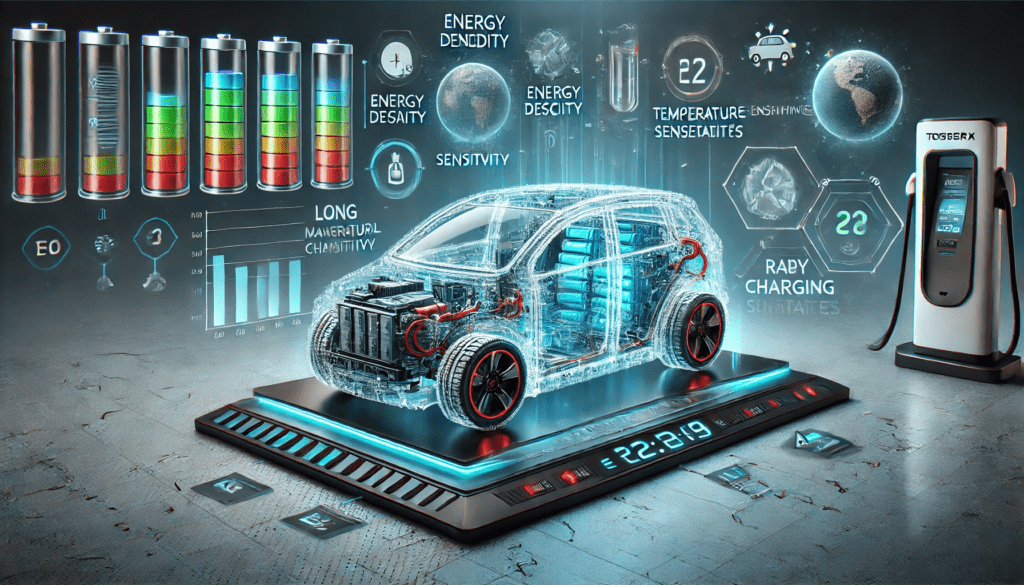
While battery technology has made significant strides in recent years, it still presents several limitations that pose challenges for electric vehicles. These limitations affect various aspects of EV performance, cost, and practicality.
Key battery technology limitations include:
- Energy density: Current lithium-ion batteries have lower energy density compared to gasoline, resulting in less energy storage per unit of weight or volume. This limitation directly impacts the range and weight of EVs.
- Charging speed: Even with fast-charging technology, EV batteries take significantly longer to “refuel” compared to filling up a gas tank.
- Degradation: Battery capacity gradually decreases over time and with use, affecting the vehicle’s range and performance in the long term.
- Temperature sensitivity: Extreme temperatures, both hot and cold, can significantly impact battery performance and charging efficiency.
- Raw material availability: The production of EV batteries relies on rare earth elements and other materials that may face supply constraints as demand increases.
- Environmental impact: While EVs produce zero tailpipe emissions, the production and disposal of batteries have environmental implications that need to be addressed.
To better understand how these limitations compare to conventional fuel, consider the following table:
| Characteristic | Lithium-ion Battery | Gasoline |
|---|---|---|
| Energy density (by weight) | 100-265 Wh/kg | ~12,000 Wh/kg |
| Refueling/Recharging time | 30 min – 12 hours | 5-10 minutes |
| Lifespan | 8-15 years | N/A (engine lifespan) |
| Temperature sensitivity | High | Low |
| Raw material availability | Limited | Established supply chains |
Let’s delve deeper into each of these limitations:
- Energy density:
The lower energy density of batteries compared to gasoline means that EVs need large, heavy battery packs to achieve acceptable ranges. This added weight can impact vehicle performance and efficiency. Researchers are working on new battery chemistries, such as solid-state batteries, that promise higher energy densities, but these technologies are still in development. - Charging speed:
While DC fast charging has significantly reduced charging times, it still takes considerably longer to charge an EV than to fill up a gas tank. This limitation can be particularly problematic for long-distance travel or in situations where quick turnaround is necessary. Faster charging technologies are in development, but they also raise concerns about battery longevity and grid capacity. - Degradation:
All batteries experience some level of degradation over time, which results in reduced capacity and range. The rate of degradation depends on various factors, including:
- Charging habits (frequent fast charging can accelerate degradation)
- Temperature exposure
- Depth of discharge cycles
- Overall usage
Most EV manufacturers offer battery warranties that guarantee a certain percentage of original capacity (typically 70-80%) for a specified period (usually 8-10 years). However, the prospect of reduced range over time remains a concern for many potential EV buyers.
- Temperature sensitivity:
Extreme temperatures can significantly affect battery performance:
- Cold temperatures can reduce range by up to 40% due to increased internal resistance and the energy required for battery heating.
- Hot temperatures can accelerate battery degradation and pose safety risks if not properly managed.
EV manufacturers are implementing various thermal management systems to mitigate these issues, but temperature sensitivity remains a challenge, particularly in regions with extreme climates.
- Raw material availability:
The production of lithium-ion batteries relies on materials such as lithium, cobalt, nickel, and graphite. As EV production scales up, there are concerns about the long-term availability and sustainability of these materials. Some key issues include:
- Geopolitical concerns: Many raw materials are concentrated in a few countries, raising supply chain risks.
- Ethical concerns: Some materials, like cobalt, have been associated with unethical mining practices.
- Environmental impact: Mining and processing these materials can have significant environmental consequences.
To address these concerns, researchers are exploring alternative battery chemistries that use more abundant materials, and the industry is working to improve recycling processes to create a more circular supply chain.
- Environmental impact:
While EVs produce zero tailpipe emissions, the production and disposal of batteries have environmental implications:
- Manufacturing emissions: The production of EV batteries is energy-intensive and can result in significant CO2 emissions.
- End-of-life disposal: Proper recycling of EV batteries is crucial to minimize environmental impact and recover valuable materials.
- Electricity source: The overall environmental benefit of EVs depends heavily on the cleanliness of the electricity grid used for charging.
The industry is addressing these issues through improved manufacturing processes, the development of more efficient recycling technologies, and the increasing use of renewable energy for both manufacturing and charging.
Despite these limitations, battery technology is rapidly advancing. Researchers and manufacturers are working on several promising developments:
- Solid-state batteries: These could offer higher energy density, faster charging, and improved safety.
- Silicon anodes: Replacing graphite anodes with silicon could significantly increase energy density.
- New cathode materials: Alternative materials could reduce reliance on cobalt and other scarce resources.
- Advanced battery management systems: These can optimize battery performance and longevity.
- Improved recycling technologies: More efficient recycling processes could create a more sustainable battery lifecycle.
As these technologies mature, many of the current limitations of battery technology may be overcome, further enhancing the viability and appeal of electric vehicles. However, it’s important to note that bringing new battery technologies from the laboratory to mass production is a complex and time-consuming process, often taking a decade or more.
Now that we have explored the challenges facing electric vehicles, including limited driving range, charging infrastructure issues, higher initial costs, and battery technology limitations, we can better understand the hurdles that need to be overcome for widespread EV adoption. Despite these challenges, the electric vehicle industry continues to innovate and improve, bringing us closer to a future where EVs are the norm rather than the exception. In the next section, we’ll examine the exciting developments and trends shaping the future of electric vehicles.
The Future of Electric Vehicles
Advancements in battery technology

The future of electric vehicles (EVs) is inextricably linked to the progress in battery technology. As we delve into this crucial aspect, it’s important to understand that batteries are the heart of EVs, determining their range, performance, and overall viability.
Current lithium-ion batteries have served the EV industry well, but researchers and manufacturers are constantly pushing the boundaries to develop more efficient, longer-lasting, and environmentally friendly alternatives. Let’s explore some of the most promising advancements in battery technology that are set to revolutionize the EV landscape:
- Solid-state batteries: These are considered the holy grail of battery technology. Unlike traditional lithium-ion batteries that use liquid electrolytes, solid-state batteries use solid electrolytes. This design offers several advantages:
- Higher energy density
- Faster charging times
- Improved safety (less risk of fire)
- Longer lifespan
- Lithium-sulfur batteries: These batteries promise higher energy density and lower costs compared to lithium-ion batteries. They use sulfur as the cathode material, which is abundant and inexpensive. While they currently face challenges with cycle life, ongoing research is addressing these issues.
- Sodium-ion batteries: As an alternative to lithium-ion, sodium-ion batteries are gaining attention due to the abundance and low cost of sodium. While they currently have lower energy density, they could be a viable option for applications where weight is less critical.
- Graphene-based batteries: Graphene, a single layer of carbon atoms arranged in a hexagonal lattice, has extraordinary properties that could revolutionize battery technology. Graphene-enhanced batteries promise:
- Ultra-fast charging times
- Higher capacity
- Improved durability
- Dual-carbon batteries: These batteries use carbon for both the anode and cathode, offering fast charging times, long cycle life, and improved safety. They also have the potential to be more environmentally friendly as they don’t rely on rare earth metals.
To better understand the potential impact of these advancements, let’s compare their projected performance metrics:
| Battery Type | Energy Density (Wh/kg) | Charging Time | Cycle Life | Cost ($/kWh) |
|---|---|---|---|---|
| Current Li-ion | 250-300 | 30-60 min | 500-1500 | 100-200 |
| Solid-state | 400-500 | 10-15 min | 1000-2000 | 80-150 |
| Lithium-sulfur | 400-600 | 20-30 min | 300-500 | 70-100 |
| Sodium-ion | 150-200 | 30-45 min | 2000-3000 | 50-80 |
| Graphene-enhanced | 300-500 | 5-10 min | 1500-2500 | 100-180 |
| Dual-carbon | 200-250 | 5-10 min | 3000-4000 | 60-90 |
These advancements in battery technology are not just theoretical; many are already in various stages of development and testing. For instance:
- Toyota plans to unveil its first solid-state battery-powered vehicle prototype in 2023, with commercial production targeted for 2025.
- QuantumScape has partnered with Volkswagen to bring solid-state batteries to market by 2025.
- CATL, the world’s largest EV battery manufacturer, is working on sodium-ion batteries and plans to begin mass production in 2023.
The impact of these battery advancements on the EV industry will be profound:
- Extended range: With higher energy density batteries, EVs will be able to travel much further on a single charge, potentially matching or exceeding the range of conventional gasoline vehicles.
- Faster charging: Reduced charging times will make EVs more convenient for long trips and alleviate range anxiety.
- Lower costs: As battery technology improves and production scales up, the cost of EVs is expected to decrease, making them more accessible to a wider range of consumers.
- Improved safety: Advanced battery technologies like solid-state batteries are inherently safer, reducing the risk of battery fires and increasing consumer confidence in EVs.
- Enhanced performance: Higher power output from advanced batteries will lead to improved acceleration and overall performance of EVs.
- Environmental benefits: More efficient batteries with longer lifespans will reduce the environmental impact of EV production and disposal.
As we look towards the future, it’s clear that these advancements in battery technology will play a crucial role in accelerating the adoption of electric vehicles. However, it’s important to note that bringing these technologies from the lab to mass production is a complex process that requires significant investment and time.
Expanding charging networks

With the advancement in battery technology paving the way for more efficient electric vehicles, the next critical aspect for the future of EVs is the expansion and improvement of charging networks. A robust and widespread charging infrastructure is essential to support the growing number of EVs on the road and to alleviate range anxiety among potential buyers.
The future of EV charging networks is multifaceted, encompassing several key developments:
- Increased number of charging stations:
- Public charging stations are expected to grow exponentially in the coming years.
- Major oil companies like Shell and BP are investing in EV charging networks, recognizing the shift towards electric mobility.
- Governments worldwide are setting ambitious targets for charging station installations.
- Faster charging technologies:
- Ultra-fast charging stations capable of delivering 350 kW or more are being deployed.
- These stations can add hundreds of miles of range in just 15-20 minutes, making long-distance EV travel more practical.
- Wireless charging:
- Inductive charging technology allows EVs to charge without physical connections.
- Future developments may include dynamic wireless charging, where vehicles can charge while in motion on specially equipped roads.
- Smart charging solutions:
- AI-powered systems will optimize charging based on grid demand, time of day, and user preferences.
- Vehicle-to-grid (V2G) technology will allow EVs to act as mobile energy storage units, feeding power back to the grid during peak demand.
- Standardization of charging protocols:
- Efforts are underway to standardize charging connectors and protocols globally, simplifying the charging process for users.
- Integration with renewable energy sources:
- Many charging stations are being powered by renewable energy sources like solar and wind.
- This integration will further reduce the carbon footprint of EVs.
Let’s take a closer look at some of these developments:
Ultra-fast charging
Ultra-fast charging is set to revolutionize the EV charging experience. Here’s a comparison of different charging speeds:
| Charging Type | Power Output | Charging Time (0-80%) | Miles Added per Hour |
|---|---|---|---|
| Level 1 (AC) | 1.4-1.9 kW | 20-40 hours | 3-5 |
| Level 2 (AC) | 3-19 kW | 4-10 hours | 12-60 |
| DC Fast Charging | 50-150 kW | 30-60 minutes | 150-450 |
| Ultra-fast DC | 350+ kW | 15-20 minutes | 1000+ |
The rollout of ultra-fast charging stations is already underway:
- In Europe, the IONITY network (a joint venture between BMW, Ford, Mercedes-Benz, and Volkswagen Group) is building a network of 350 kW charging stations along major highways.
- In the US, Electrify America is deploying a network of ultra-fast chargers capable of up to 350 kW.
- Tesla’s V3 Superchargers can deliver up to 250 kW, significantly reducing charging times for Tesla vehicles.
Wireless Charging
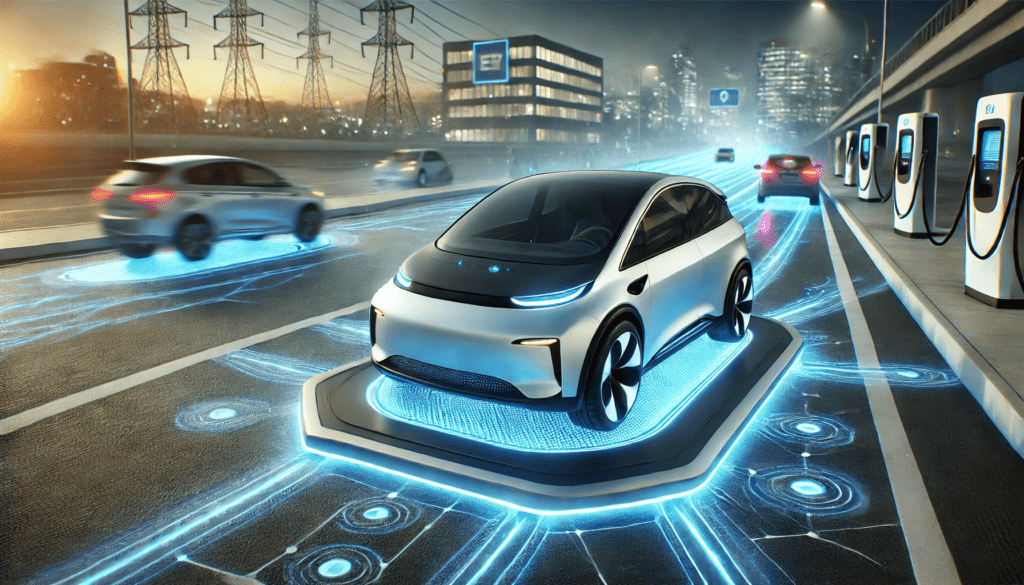
Wireless charging technology for EVs is progressing rapidly:
- Static wireless charging pads are already available for some EV models.
- Companies like WiTricity are developing more efficient wireless charging systems.
- Dynamic wireless charging is being tested in pilot projects:
- In Sweden, a 1-mile stretch of electrified road can charge vehicles as they drive.
- Similar projects are underway in Italy, France, and the UK.
Smart Charging and V2G Technology
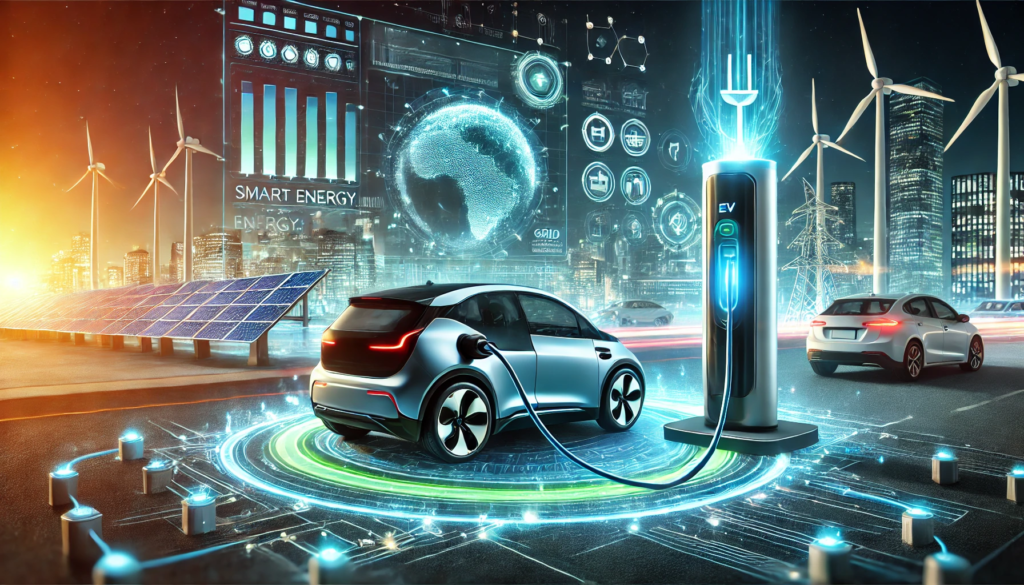
Smart charging and V2G technology will play a crucial role in managing grid load and integrating EVs into the broader energy ecosystem:
- Smart charging systems can automatically schedule charging during off-peak hours, reducing strain on the grid and potentially lowering costs for consumers.
- V2G technology allows EVs to feed power back to the grid during peak demand periods:
- This can help stabilize the grid and potentially provide additional income for EV owners.
- Nissan and EDF Energy have already launched a commercial V2G service in the UK.
Global Standardization Efforts
Efforts to standardize EV charging are gaining momentum:
- In Europe, the Combined Charging System (CCS) is becoming the standard for fast charging.
- Tesla has announced plans to open its Supercharger network to other EV brands in some regions.
- CHAdeMO, another fast-charging standard, is working on a new protocol that’s compatible with CCS.
The expansion of charging networks faces several challenges:
- Infrastructure costs: Building a comprehensive charging network requires significant investment.
- Grid capacity: As EV adoption increases, upgrades to the electrical grid may be necessary to handle the increased demand.
- Land availability: Finding suitable locations for charging stations, especially in urban areas, can be challenging.
- Maintenance and reliability: Ensuring the reliability and maintenance of a vast network of charging stations is crucial.
Despite these challenges, the future of EV charging networks looks promising. Governments, automakers, and energy companies are investing heavily in charging infrastructure:
- The European Union aims to have 1 million public charging points by 2025.
- In the US, the Biden administration has set a goal of building 500,000 new public charging stations by 2030.
- China, the world’s largest EV market, plans to have 4.8 million charging stations by 2025.
The expansion of charging networks will have far-reaching effects:
- Increased EV adoption: A robust charging infrastructure will make EVs more practical for a wider range of consumers, accelerating adoption.
- Economic opportunities: The growth of charging networks will create new jobs in installation, maintenance, and related services.
- Urban planning: Cities will need to integrate EV charging into their urban planning, potentially reshaping urban landscapes.
- Energy sector transformation: The growth of EV charging will drive changes in the energy sector, promoting the integration of renewable energy and smart grid technologies.
As we move forward, the synergy between advancements in battery technology and the expansion of charging networks will be crucial in shaping the future of electric vehicles. These developments will not only make EVs more practical and accessible but will also play a significant role in the broader transition to sustainable transportation.
Government incentives and regulations
As we transition from discussing charging infrastructure to government involvement, it’s important to recognize that the future of electric vehicles is heavily influenced by policy decisions. Governments around the world are increasingly implementing incentives and regulations to accelerate the adoption of EVs and phase out internal combustion engine (ICE) vehicles. These policies play a crucial role in shaping the automotive industry and consumer behavior.
Let’s explore the key areas of government intervention:
- Financial Incentives:
- Purchase subsidies
- Tax credits
- Reduced registration fees
- Lower electricity rates for EV charging
- Non-Financial Incentives:
- Access to HOV lanes
- Free or preferential parking
- Exemption from congestion charges
- Regulations:
- Emissions standards
- Fuel economy standards
- Zero-emission vehicle (ZEV) mandates
- ICE vehicle phase-out targets
- Infrastructure Support:
- Funding for public charging stations
- Building code requirements for EV-ready parking
- Research and Development Support:
- Grants for battery technology research
- Funding for EV manufacturing innovations
Here’s a closer look at some of these policy areas:
Financial Incentives
Financial incentives have been a powerful tool in promoting EV adoption. Here’s a comparison of EV incentives in some key markets:
| Country | Purchase Incentive | Tax Credit | Other Benefits |
|---|---|---|---|
| USA | Up to $7,500 | Varies by state | HOV lane access in some states |
| China | Up to $3,700 | Exemption from purchase tax | Preferential parking in some cities |
| Germany | Up to €9,000 | Exemption from vehicle tax for 10 years | Free parking in some cities |
| Norway | No VAT (25%) | Exemption from purchase tax | Free parking, toll exemptions |
| Japan | Up to ¥400,000 | Reduced vehicle tax | Subsidies for charging equipment |
These incentives have had a significant impact on EV sales. For instance, Norway, which offers the most comprehensive incentive package, has the highest EV market share globally, with EVs accounting for over 50% of new car sales in 2020.
However, as EV adoption increases and technology improves, many countries are planning to phase out or reduce these incentives. The challenge for policymakers is to time this transition carefully to avoid disrupting market growth.
Regulations
Regulatory measures are becoming increasingly important in driving the transition to EVs:
- Emissions Standards: Many countries are tightening vehicle emissions standards, indirectly promoting EV adoption:
- The EU’s Euro 7 standards, set to be implemented in 2025, will further reduce allowable emissions from new vehicles.
- In the US, the Biden administration has proposed stricter fuel economy standards, aiming for an average of 52 mpg for new vehicles by 2026.
- ZEV Mandates: Some regions require automakers to sell a certain percentage of zero-emission vehicles:
- California’s ZEV program requires automakers to earn credits by selling EVs or face penalties.
- China’s New Energy Vehicle (NEV) mandate sets targets for EV production and sales.
- ICE Phase-out Targets: Many countries have announced plans to ban the sale of new ICE vehicles:
- Norway: 2025
- UK, Netherlands, Ireland: 2030
- France, Spain, Canada: 2035
- China: Studying a timeline for phasing out ICE vehicles
These regulations send a clear signal to automakers and consumers about the direction of the automotive industry, encouraging investment in EV technology and infrastructure.
Infrastructure Support
Governments are increasingly recognizing the importance of charging infrastructure in EV adoption:
- The EU’s Alternative Fuels Infrastructure Regulation proposes mandatory targets for charging points along major highways.
- In the US, the Infrastructure Investment and Jobs Act includes $7.5 billion for EV charging infrastructure.
- China aims to build 120,000 new charging stations in 2021 alone.
Many countries are also implementing building codes that require new constructions to be “EV-ready,” with pre-wiring for charging stations. This proactive approach can significantly reduce the cost and complexity of installing charging infrastructure in the future.
Research and Development Support
Government support for R&D is crucial for advancing EV technology:
- The US Department of Energy’s Vehicle Technologies Office provides funding for battery research, including a $209 million initiative announced in 2021 to accelerate EV technologies.
- The EU’s Horizon Europe program includes significant funding for clean vehicle research.
- China’s New Energy Vehicle Industry Development Plan (2021-2035) emphasizes support for technological innovation in the EV sector.
These investments are critical for achieving breakthroughs in areas like battery technology, which we discussed earlier.
The impact of government policies on the future of EVs is profound:
- Accelerated Adoption: Financial incentives and regulations are driving faster EV adoption rates.
- Technology Advancement: R&D support is accelerating improvements in EV technology.
- Infrastructure Development: Government funding is crucial for building out charging networks.
- Industry Transformation: Clear policy signals are encouraging automakers to shift their focus to EVs.
- Job Creation: The transition to EVs is creating new jobs in manufacturing, infrastructure, and related services.
However, policy-making in this area also faces challenges:
- Balancing Incentives: Governments must carefully balance financial incentives to avoid market distortions while still encouraging adoption.
- Grid Impact: As EV adoption increases, policies must address the potential impact on electrical grids.
- Equity Concerns: There are concerns that EV incentives primarily benefit higher-income consumers.
- International Coordination: Different policies across countries can create complications for global automakers.
Looking ahead, we can expect government policies to continue evolving:
- Financial incentives may shift from direct purchase subsidies to support for charging infrastructure and battery recycling.
- Regulations are likely to become more stringent, with more countries announcing ICE phase-out dates.
- Policies may increasingly focus on commercial and public transport fleets, which can have a significant impact on emissions.
- There may be more emphasis on the entire lifecycle of EVs, including battery production and recycling.
As we consider the future of electric vehicles, it’s clear that government incentives and regulations will continue to play a pivotal role. These policies, combined with technological advancements and expanding infrastructure, are setting the stage for
Choosing the Right Electric Vehicle
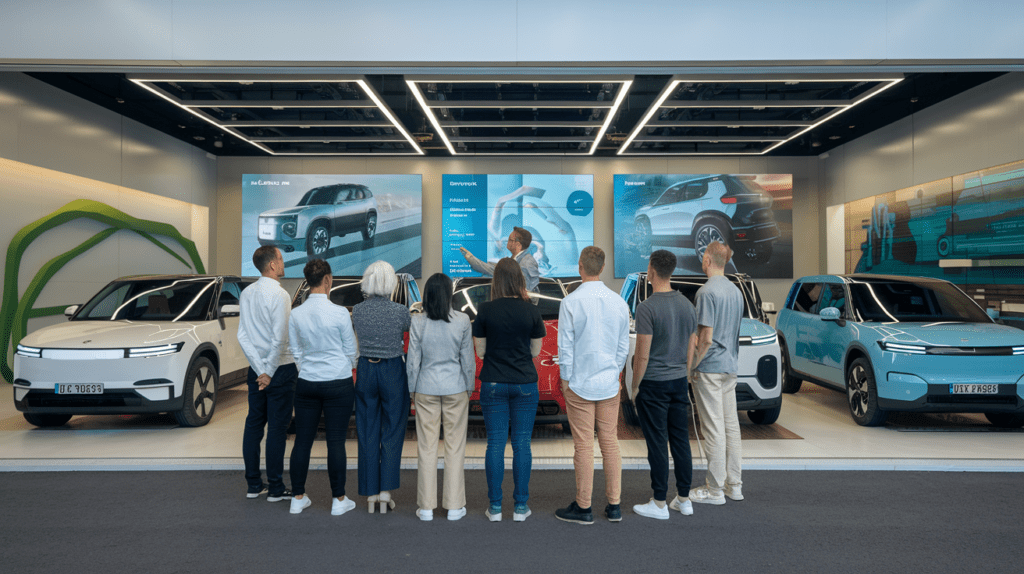
Assessing your driving needs
When it comes to choosing the right electric vehicle (EV), the first step is to carefully assess your driving needs. This crucial evaluation will help you narrow down your options and find an EV that perfectly fits your lifestyle and requirements.
To begin, consider the following factors:
- Daily commute distance
- Frequency of long-distance trips
- Typical driving conditions (urban, highway, or mixed)
- Number of passengers you usually transport
- Cargo space requirements
Let’s break down each of these factors to help you make an informed decision:
Daily commute distance
Your daily driving distance is perhaps the most critical factor in choosing an EV. Most modern electric vehicles offer a range between 100 and 300 miles on a single charge, which is more than sufficient for the average daily commute.
To determine if an EV’s range meets your needs:
- Calculate your round-trip commute distance
- Add any additional miles for errands or detours
- Consider potential range reduction due to weather conditions or highway driving
For example, if your daily round-trip commute is 50 miles, and you occasionally run errands that add another 20 miles, an EV with a range of 150-200 miles would be more than adequate for your needs.
Frequency of long-distance trips
While most EVs can easily handle daily commutes, long-distance trips require more careful planning. Consider how often you take extended trips and the typical distances involved.
If you frequently travel long distances, you may want to consider:
- An EV with a longer range (300+ miles)
- A plug-in hybrid electric vehicle (PHEV) that can switch to gas power for longer trips
- An EV with fast-charging capabilities for quicker pit stops
Remember that the growing network of charging stations makes long-distance EV travel increasingly feasible, but it still requires more planning than traditional gas-powered vehicles.
Typical driving conditions
Your typical driving conditions can significantly impact your EV’s performance and range. Consider the following scenarios:
- Urban driving: EVs excel in stop-and-go traffic due to regenerative braking, which helps recharge the battery during deceleration.
- Highway driving: Consistent high speeds can drain the battery faster, potentially reducing range.
- Hilly terrain: Climbing hills requires more energy, which can decrease range, but regenerative braking helps recapture some energy when going downhill.
- Extreme temperatures: Both very hot and very cold weather can affect battery performance and reduce range.
Based on your typical driving conditions, you may want to prioritize features like:
- Enhanced regenerative braking for urban driving
- Aerodynamic design for highway efficiency
- All-wheel drive for challenging terrain or weather conditions
- Battery thermal management systems for extreme climates
Number of passengers
Consider how many passengers you typically transport. This will help you determine the appropriate size and seating capacity of your EV. Options range from compact two-seaters to spacious SUVs with seating for seven or more passengers.
Here’s a quick guide to help you choose:
| Passengers | Suitable EV Types |
|---|---|
| 1-2 | Compact cars, sports EVs |
| 3-5 | Sedans, small SUVs |
| 6+ | Large SUVs, minivans |
Remember that larger vehicles with more seating capacity often have lower range due to their increased weight and size.
Cargo space requirements
Lastly, consider your cargo space needs. Whether you’re transporting groceries, sports equipment, or work-related items, ensure the EV you choose can accommodate your typical load.
Some factors to consider:
- Trunk or cargo area capacity (in cubic feet)
- Foldable rear seats for additional space
- Roof rack compatibility for extra storage
- Towing capacity (if needed)
Many EVs offer innovative storage solutions, such as front trunks (“frunks”) in addition to rear cargo areas, providing more versatility than their gas-powered counterparts.
By thoroughly assessing your driving needs across these key areas, you’ll be well-equipped to move on to the next step: comparing different EV models that meet your specific requirements.
Comparing different EV models
Now that you’ve assessed your driving needs, it’s time to dive into the exciting world of electric vehicle models. With the rapidly growing EV market, there’s a wide array of options to choose from, each with its own unique features and capabilities.
To help you navigate this landscape, we’ll explore several key aspects to consider when comparing EV models:
- Range and battery capacity
- Performance and power
- Charging speed and compatibility
- Safety features and ratings
- Technology and infotainment systems
- Design and aesthetics
- Brand reputation and reliability
Range and battery capacity
Range is often the top concern for potential EV buyers. When comparing models, pay close attention to:
- EPA-estimated range
- Battery capacity (measured in kilowatt-hours or kWh)
- Real-world range reports from owners and reviewers
Keep in mind that actual range can vary based on driving conditions, weather, and personal driving habits. Some EVs known for their impressive range include:
- Tesla Model S Long Range Plus (402 miles)
- Tesla Model 3 Long Range (353 miles)
- Ford Mustang Mach-E Extended Range (305 miles)
- Chevrolet Bolt EV (259 miles)
- Hyundai Kona Electric (258 miles)
Remember, while a longer range is generally desirable, it often comes with a higher price tag. Balance your range needs with your budget to find the best fit.
Performance and power
Electric vehicles are known for their instant torque and smooth acceleration. When comparing performance, consider:
- Horsepower and torque
- 0-60 mph acceleration time
- Top speed
- Driving modes (e.g., eco, sport, performance)
Many EVs offer impressive performance metrics. For example:
| EV Model | Horsepower | 0-60 mph |
|---|---|---|
| Tesla Model S Plaid | 1,020 hp | 1.99 seconds |
| Porsche Taycan Turbo S | 750 hp | 2.6 seconds |
| Ford Mustang Mach-E GT | 480 hp | 3.5 seconds |
| Audi e-tron GT | 522 hp | 3.9 seconds |
While high performance can be exhilarating, remember that aggressive driving can significantly impact range and energy efficiency.
Charging speed and compatibility
Fast charging capabilities can make a big difference in your EV ownership experience, especially for long trips. Consider:
- Level 2 (240V) charging speed
- DC fast charging speed and compatibility
- Maximum charging rate (in kW)
- Charging port type (e.g., CCS, CHAdeMO, Tesla proprietary)
For example, the Tesla Model 3 can add up to 175 miles of range in just 15 minutes at a Supercharger station, while the Porsche Taycan can charge from 5% to 80% in about 22.5 minutes using a 350 kW DC fast charger.
Also, check the compatibility of different EV models with charging networks in your area. Some manufacturers, like Tesla, have their own proprietary charging networks, while others rely on third-party networks like Electrify America or ChargePoint.
Safety features and ratings
Safety should be a top priority when choosing any vehicle. When comparing EV models, look for:
- NHTSA safety ratings (5-star scale)
- IIHS safety ratings (Good, Acceptable, Marginal, Poor)
- Advanced driver assistance systems (ADAS)
- Automatic emergency braking
- Lane departure warning and lane-keeping assist
- Blind-spot monitoring
- Adaptive cruise control
Many EVs excel in safety ratings due to their low center of gravity and advanced technology. For instance, the Tesla Model 3 and Model Y have both received 5-star ratings from NHTSA and are Top Safety Picks+ from IIHS.
Technology and infotainment systems
Electric vehicles often come packed with cutting-edge technology. Compare models based on:
- Infotainment system size and responsiveness
- Smartphone integration (Apple CarPlay, Android Auto)
- Over-the-air software updates
- Advanced features like autopilot or self-parking
- Voice control capabilities
- Digital instrument clusters
- Heads-up displays
Some standout technology features in EVs include:
- Tesla’s large touchscreen interface and Autopilot system
- Ford’s SYNC 4A system with natural voice recognition
- Volkswagen’s ID. Light communication strip
- Rivian’s Driver+ advanced driver assistance system
Design and aesthetics
While subjective, the design and aesthetics of an EV can play a significant role in your decision. Consider:
- Exterior styling (traditional, futuristic, or somewhere in between)
- Interior design and materials
- Customization options (colors, wheels, trim levels)
- Aerodynamics (which can impact range and efficiency)
Some EVs aim for a futuristic look, like the Tesla Cybertruck or BMW i3, while others maintain a more traditional appearance, like the Ford Mustang Mach-E or Volkswagen ID.4.
Brand reputation and reliability
Finally, consider the reputation and reliability of different EV brands. Look into:
- Consumer reports and reviews
- Warranty coverage (particularly for the battery)
- Service network and availability
- Brand history with EVs and technological innovation
While traditional automakers like Ford, GM, and Volkswagen bring decades of manufacturing experience to their EVs, newer companies like Tesla and Rivian have been at the forefront of EV innovation.
By carefully comparing these aspects across different EV models, you’ll be able to create a shortlist of vehicles that best meet your needs and preferences. This thorough comparison will set you up for success as you move on to the next crucial step: understanding charging options.
Understanding charging options
One of the most significant differences between owning an electric vehicle and a traditional gas-powered car is the charging process. Understanding your charging options is crucial for a smooth transition to EV ownership and to ensure that your vehicle always has the power it needs.
Let’s explore the different types of EV charging, home charging solutions, public charging networks, and workplace charging options.
Types of EV charging
There are three main levels of EV charging:
- Level 1 (120V AC)
- Level 2 (240V AC)
- Level 3 (DC Fast Charging)
Here’s a breakdown of each level:
| Charging Level | Voltage | Typical Use | Charging Speed |
|---|---|---|---|
| Level 1 | 120V AC | Home (standard outlet) | 2-5 miles of range per hour |
| Level 2 | 240V AC | Home, workplace, public | 10-60 miles of range per hour |
| Level 3 (DC Fast) | 400V-900V DC | Public charging stations | 3-20 miles of range per minute |
Home charging solutions
Home charging is the most convenient and cost-effective way to keep your EV powered up. Here are your main options:
- Level 1 charging:
- Uses a standard 120V household outlet
- Slowest charging method
- No additional equipment needed
- Ideal for plug-in hybrids or if you have a short daily commute
- Level 2 charging:
- Requires a 240V outlet (similar to a dryer or oven)
- Significantly faster than Level 1
- Requires installation of a home charging station (EVSE)
- Most popular option for home charging
When considering a Level 2 home charging station, look for:
- Amperage (higher amperage means faster charging)
- Smart features (Wi-Fi connectivity, scheduling, energy monitoring)
- Cable length
- Indoor/outdoor rating
- Safety certifications (UL Listed)
Popular Level 2 home charging stations include:
- ChargePoint Home Flex
- JuiceBox 40
- Electrify America HomeStation
- Tesla Wall Connector (for Tesla vehicles)
Installation costs for a Level 2 charger can range from $500 to $2,000, depending on your home’s electrical setup and local labor costs. Many utility companies offer rebates or incentives for installing home charging stations, so be sure to check with your local provider.
Public charging networks
Public charging stations are essential for extending your EV’s range on long trips and providing a charging solution for those without home charging capabilities. Major public charging networks include:
- Tesla Supercharger Network (exclusive to Tesla vehicles)
- Electrify America
- ChargePoint
- EVgo
- Blink
When using public charging stations, consider:
- Charging speeds (Level 2 vs. DC Fast Charging)
- Compatibility with your vehicle’s charging port
- Payment methods (credit card, mobile app, RFID card)
- Reliability and maintenance of the network
- Location and availability of stations along your route
To find public charging stations, use apps like:
- PlugShare
- ChargePoint
- Electrify America
- A Better Route Planner (ABRP)
These apps can help you plan trips, locate stations, and even check real-time availability.
Workplace charging
Many employers are now offering workplace charging as an employee benefit. This can be especially helpful for those who:
- Live in apartments or homes without easy charging access
- Have a long commute
- Want to extend their EV’s range for after-work activities
If your workplace doesn’t currently offer EV charging, consider talking to your employer about the benefits of installing charging stations, such as:
- Attracting and retaining employees
- Demonstrating environmental commitment
- Potential tax incentives for businesses
Charging etiquette and best practices
As you navigate the world of EV charging, keep these etiquette tips in mind:
- Don’t leave your car at a public charger longer than necessary
- Move your vehicle once charging is complete to free up the spot for others
- Avoid unplugging other vehicles unless they’re fully charged and the owner has left a note permitting it
- Be mindful of time limits at charging stations
- Report any issues with charging stations to the network operator
Planning for charging
To ensure a smooth EV ownership experience:
- Assess your daily and weekly charging needs
- Determine if home charging is feasible and what level you’ll need
- Research public charging options in your area and along frequently traveled routes
- Consider workplace charging availability
- Familiarize yourself with charging apps and payment methods
- Understand your vehicle’s charging capabilities and limitations
By thoroughly understanding your charging options, you’ll be well-prepared to keep your EV powered up and ready to go. This knowledge will serve you well as we move on to our final consideration: the total cost of ownership for an electric vehicle.
Considering total cost of ownership
When evaluating whether an electric vehicle is right for you, it’s crucial to look beyond the sticker price and consider the total cost of ownership (TCO). This comprehensive approach takes into account various factors that contribute to the overall expense of owning and operating an EV over time.
Let’s break down the key components of TCO for electric vehicles:
- Initial purchase price
- Available incentives and tax credits
- Charging costs
- Maintenance and repairs
- Insurance
- Depreciation
- Potential savings compared to gas-powered vehicles
Initial purchase price
Electric vehicles typically have higher upfront costs compared to their gas-powered counterparts. However, this gap is narrowing as battery technology improves and production scales up. When considering the purchase price:
- Compare similar vehicle classes (e.g., compact EVs with compact gas cars)
- Look at both premium and more affordable EV options
- Consider leasing as an alternative to buying, especially if you’re new to EVs
Some popular EVs and their starting prices (as of 2023):
- Chevrolet Bolt EV: $26,500
- Nissan Leaf: $28,040
- Tesla Model 3: $40,240
- Ford Mustang Mach-E: $45,995
- Volkswagen ID.4: $38,995
Remember that these prices are before any applicable incentives or tax credits.
Available incentives and tax credits
Various incentives can significantly reduce the cost of purchasing an EV:
- Federal tax credits: Up to $7,500 for eligible vehicles
- State and local incentives: Vary by location, can include rebates, tax credits, or other perks
- Utility company incentives: Some offer rebates for home charging installation or special EV electricity rates
For example, the federal tax credit structure for EVs (as of 2023) includes:
| Credit Amount | Eligibility Criteria |
|---|---|
| Up to $7,500 | New EVs assembled in North America, battery components sourced from US or free trade agreement partners |
| Up to $4,000 | Used EVs (max 30% of sale price) |
Always check the latest incentives available in your area, as they can change over time.
Charging costs
Charging costs can vary widely depending on your charging habits and local electricity rates. To estimate your charging costs:
- Calculate your average daily mileage

Electric vehicles represent a significant shift in the automotive industry, offering numerous benefits such as reduced emissions, lower operating costs, and improved energy efficiency. While challenges like limited range and charging infrastructure persist, ongoing technological advancements and increasing government support are rapidly addressing these issues.
As we look to the future, electric vehicles are poised to play a crucial role in sustainable transportation. Whether you’re considering making the switch or simply curious about the technology, understanding the various options and factors involved in choosing an electric vehicle can help you make an informed decision. Embracing this eco-friendly transportation solution not only benefits the environment but also contributes to a cleaner, more sustainable future for generations to come.
Visit website, click on this link: Autobiography Zone